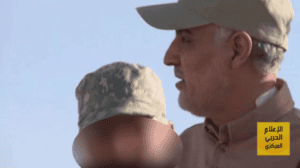
Qassem Soleimani “by the Syrian border with Iraq,” according to pro-Hezbollah media arm, posted June 13.
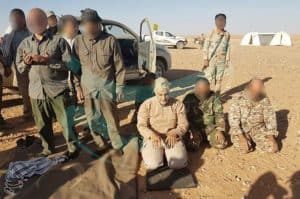
Soleimani giving a prayer of thanks, according to Guard-affiliated media, posted June 12.
A Lebanese Hezbollah media arm released a photo of Iran’s Revolutionary Guard Qods Force chief Qassem Soleimani today “by the Syrian border with Iraq.” On Monday, Tasnim News Agency – a propaganda outlet affiliated with the Guard Corps – posted photos of Soleimani allegedly by the Iraqi border in Syria. The precise location and date of these photos are unclear.
The promotion of the Iranian general’s recent photos underscore the importance of operations in the Iraq-Syria border area to the Islamic Republic as the Islamic State’s territorial hold collapses.
Soleimani was previously spotted in Tehran late last month. Prior to that, he was photographed close to the Syrian border in northwest Iraq, according to social media posts and Iranian media outlets.
In the latest picture, Soleimani was seen giving a prayer of gratitude in desert and visiting Afghan Fatemiyoun Division militiamen under his command, according to Tasnim. This unit has been operating near the Coalition military base at Tanf, and has assisted pro-regime forces in offensives near Palmyra in central Syria and toward the Iraqi border.
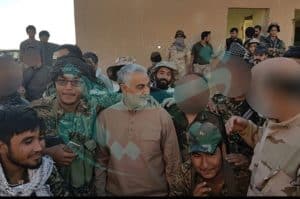
Soleimani with Fatemiyoun Division combatants, posted June 12.
Several Iranian-backed militias have taken photos by the Iraqi border in Syria as they move toward that front. These militias included the Iraqi Ansar Allah al Awfiya in Iraq and Syria, al Jihad Companies and the Seyyed al Shuhada Brigades. The Iraqi Imam Ali Brigades, Harakat al Abdal and Harakat al Nujaba have also been spotted on that front. These groups are members of the Popular Mobilization Forces (PMF), which was enshrined into a permanent security institution in Iraq last year, thus technically making these militias Iraqi security forces that are de facto allied with the US in Iraq. The Syrian Imam al Baqir Brigade and the Sayida Roqaya Brigade have deployed to the southeastern Syrian front, as well. Lebanese Hezbollah has furthermore deployed some forces to that front, according to Guard-affiliated media.
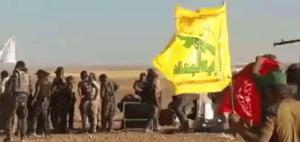
Flag of the Jihad Companies.
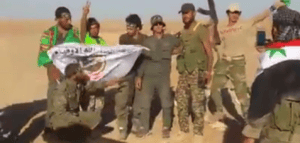
Flag of Ansar Allah al Awfiya in Iraq and Syria.
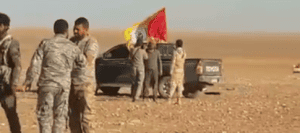
Flag of the Sayyid al Shuhada Brigades.
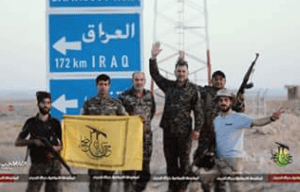
Harakat al Nujaba moving toward Tanf front, posted June 12.
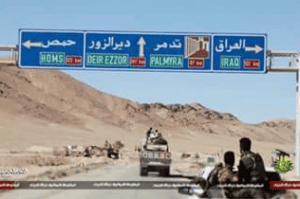
Harakat al Nujaba moving toward Tanf front, posted June 12.
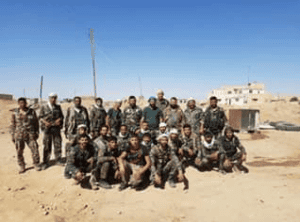
Al Imam al Baqir Brigade in the Tanf front, according to social media post, posted June 7.
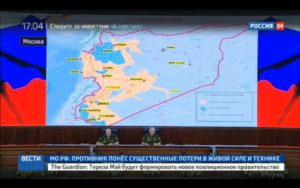
Last week, pro-regime forces in Syria claimed they reached the Iraqi border northeast of the US Tanf base, just outside the “deconfliction” zone. According to pro-regime claims, US forces agreed to Russia’s request to reach al Boudah village by the border, and US-backed Free Syrian Army (FSA)-branded forces withdrew from the area. The Russian defense ministry released a map of pro-regime forces reaching the Iraqi border (right), and a Syrian propaganda outlet published images of several soldiers raising the Syrian regime flag. Russia has also deployed assets there, as reflected in yesterday’s statement by Defense Secretary James Mattis before the Senate.
The pro-regime forces’ presence and line of communication is more tenuous than the pro-regime propaganda claims. General Joseph Dunford, the chairman of the Joint Chiefs of Staff, denied before the Senate yesterday that pro-regime forces have encircled US forces in Tanf: “We still have freedom of movement outside of the Tanf area … we are not limited from moving up toward the Euphrates River valley,” according to comments carried in Stripes. Later in the day, CNN citing US officials reported the deployment of High Mobility Artillery Rocket System (HIMARS) from Jordan to Tanf, boosting US combat power.
The tactical circumstances surrounding the latest pro-regime movements toward the Iraqi border are thus far unclear, and the situation on the ground is very fluid.
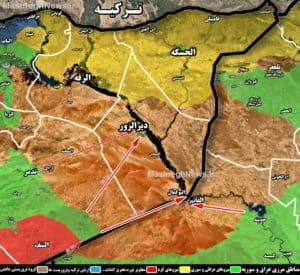
Map 1: Guard-affiliated media outlet’s map on potential movements in Iraq and Syria, posted June 12. However, PMF forces have announced plans to move southward to Qaim-Albukamal border crossing in west Anbar. Credit: Mashregh News.
Iran and the pro-regime alliance are attempting to maximize their gains in the Iraq-Syria border area. In Iraq, the PMF last month reached the border with Syria in the northwestern countryside and is moving southward toward the Qaim-Albukamal border crossing in west Anbar province. Meanwhile, pro-regime forces in Syria have launched offensives in southern and central Syria. They seek to reach the besieged Deir Ezzor, capture a major border crossing into Iraq and deny territory to US and US-backed forces. That is reflected in announcements and a map released by Guard-affiliated Mashregh News, which boasts that linking forces and especially the capture of the Qaim-Albukamal crossing would re-establish a land route from Tehran to the Levant for the first time in 6 years, facilitating the movement of manpower and materiel.
If successful – and this is a big if at this time – a viable land crossing between Iraq and Syria would complement Iran’s air bridge to Syria, though achieving and holding that faces significant hurdles, such as a potential US-backed advancement into Deir Ezzor by the Iraqi border.
In the past month, the US has struck pro-regime forces including Iranian-backed militias three times and has downed an Iranian Shahed-129 drone inside the US deconfliction zone.
In the US military’s latest announcement on the clashes in Tanf, it stated that it sought to de-escalate and only focus on the campaign against the Islamic State, though warned about the risk of escalation “as long as pro-regime forces are oriented toward coalition and partner forces.”
That statement makes sense. As the US calibrates its anti-Islamic State strategy in eastern Syria and pro-regime forces challenge the US in a bid to gain territory, the risk of further clashes persists.







